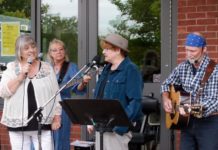by Peter Johnson
“After the second World War, there had been attempts by the English Folk Dance and Song Society in London and Birmingham to form clubs where traditional music could be performed. The clubs were known for the amateur nature of their performances, often including, or even focusing on local ‘floor singers’, of members who would step up to sing one or two songs.
In America, The Lovin’ Spoonful is one example of a pop group that started in the folk club world. In Boston, the most famous venue was the Club 47, where Joan Baez got her start.” (Wikipedia)
Roughly 10 years ago, on the patio out back of The Branch Restaurant, Bruce Enloe, George Hogan and myself escaped from the crowded, noisy interior. George wanted to introduce us to the concept of ‘Folk Clubs’, UK style.
What came out of that initial discussion was a concept for live performances where performers came up from the audience, to the stage and performed 3 songs. The venue would be a ‘listening room’. Any who wished to carry on a conversation would be asked to move their ‘meeting’ to a side room, or outside.
Central to this model of performance was the idea that the performer was the focus of the room. Not having to be in competition with the usual noise of a busy room, they were then free to do their music. And the audience was also able to listen without the distractions from chatty neighbours. I was immediately enthused. I knew well the feeling of performing to a room of people who were more intent on their conversations…I also was familiar with how irritating it could be to have chatty neighbours ruin your listening experience.
I had just retired from 30+ years of teaching. In any ‘good’ classroom, it is essential that when someone is speaking, everyone else listens. These ‘audience manners’ promote learning, as well as the sharing of ideas and information. Mentoring and partnerships were another part of a positive learning environment. I wanted to incorporate these concepts into a public performance situation.
Bruce and Nicole allowed us to use their facility on a week night when The Branch was closed. Every second week we would gather. A list was made up…a performance schedule on the basis of ‘first come, first served’. Our numbers grew. If you were late, you did not get on the list. We had experienced musicians as well as those who had never performed to a live audience before. It was a place where many new collaborations were being tried out and where positive but realistic feedback was encouraged.
Within the group at large, musicians shared their talents and joined up in groups of two, three…sometimes more. It was a time of sharing, learning, co-operation and growth. And then, along came COVID.
Everything that made the Folk Club what it was, was no longer possible. The Kemptville Folk Club went on a two year hiatus. Restaurants were no longer gathering places.
During that time, The Branch became the Branch Bistro. As we eased our way out of the pandemic, the building was transformed into The Hyde.
The Folk Club has had to adjust. The food and entertainment sector is struggling: both to find staff and to get patrons to return. With this in mind, The Kemptville Folk Club has had to search for a facility that will meet its particular needs. To date the search continues. I am hoping that there will be some good news soon. When we are up and running again, we will make that news known. If this sounds like something you’d like to participate in, or to attend as an audience member, you will be able to contact me through our Facebook page.






